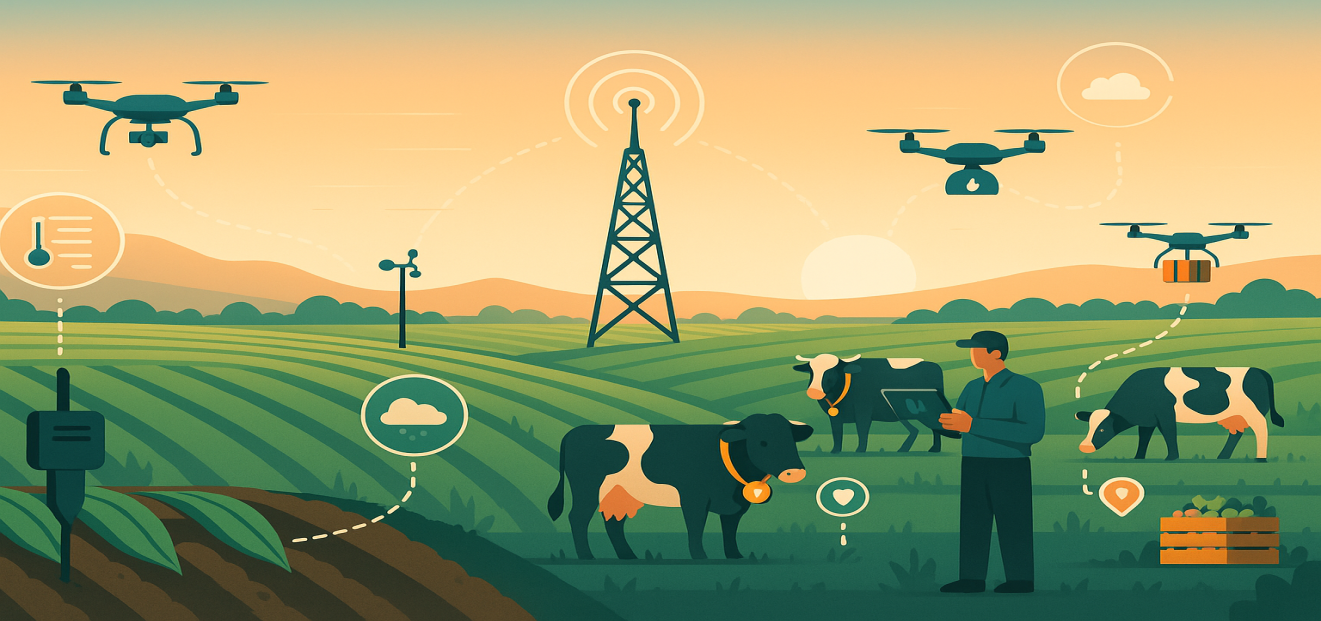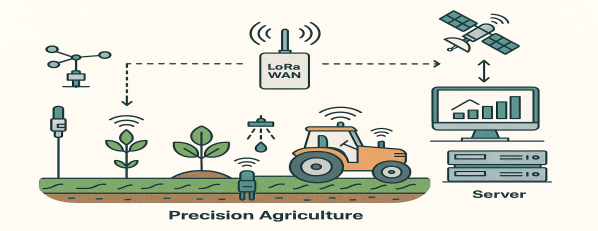

The agricultural landscape is undergoing a dramatic transformation through the integration of LoRaWAN (Long Range Wide Area Network) technology. This innovative wireless communication protocol enables farmers to connect and monitor various aspects of their operations from remote locations, marking a significant leap in farming efficiency.
Precision farming uses data-driven insights to optimize crop yields, reduce resource waste, and enhance farm productivity. By deploying smart sensors across fields, farmers can track crucial parameters like:
- Soil moisture levels
- Temperature variations
- Crop health indicators
- Weather conditions
- Equipment performance
LoRaWAN's unique capabilities make it particularly suited for agricultural applications. Its long-range coverage spans several kilometers, while its low power consumption ensures sensors can operate for years without battery replacement. These features create an ideal foundation for smart farming solutions in rural areas where traditional connectivity options might be limited.
This article explores the transformative applications of LoRaWAN in precision farming, examining how this technology helps farmers address modern agricultural challenges while increasing productivity and sustainability.
Understanding LoRaWAN Technology in Agriculture
LoRaWAN is an innovative wireless protocol designed specifically for Internet of Things (IoT) applications in agriculture. This technology operates on unlicensed radio frequencies, enabling long-range communication up to 10 kilometers in rural areas and low power consumption that extends device battery life up to 15 years.
Key features of LoRaWAN in agricultural settings:
- Extended Range: Signals penetrate dense crop fields and reach remote areas where traditional networks struggle
- Energy Efficiency: Sensors operate for years on a single battery charge
- Cost-Effective: Uses free radio spectrum, reducing operational expenses
- Robust Security: Built-in AES-128 encryption protects sensitive farm data
LoRaWAN outperforms traditional wireless technologies in agricultural environments:
- Cellular networks: Higher power consumption, expensive data plans
- Wi-Fi: Limited range, requires multiple access points
- Bluetooth: Short-range, unsuitable for large-scale farming
The technology seamlessly integrates with existing wireless infrastructure through multi-protocol gateways. These gateways create a unified network architecture where LoRaWAN devices communicate alongside Bluetooth sensors, Wi-Fi equipment, and cellular systems. This compatibility enables farmers to:
- Deploy hybrid monitoring solutions
- Maintain existing equipment investments
- Scale operations without infrastructure overhaul
- Connect different types of agricultural sensors and devices
The adaptable nature of LoRaWAN makes it ideal for both small family farms and large commercial operations, providing a scalable foundation for modern precision agriculture.
Key Challenges in Modern Agriculture Addressed by LoRaWAN
Modern agriculture faces unprecedented challenges as global population projections point to 9.7 billion people by 2050. This surge in population creates intense pressure on existing agricultural resources:
1. Limited Land Resources
- Arable land decreases by 1% annually due to urbanization
- Existing farmland must produce higher yields
- Competition between food crops and biofuel production
2. Water Scarcity
- Agriculture consumes 70% of global freshwater
- Groundwater depletion in major farming regions
- Irregular rainfall patterns due to climate change
3. Soil Quality Degradation
- Intensive farming practices deplete soil nutrients
- Chemical fertilizer dependency reduces natural fertility
- Erosion threatens topsoil preservation
LoRaWAN-enabled precision farming addresses these challenges through real-time data collection and analysis:
- Smart sensors monitor soil moisture levels
- Automated systems optimize water distribution
- Precision fertilizer application preserves soil health
- Weather stations provide localized climate data
These data-driven insights enable farmers to make informed decisions about resource allocation, reducing waste while maximizing crop yields. The technology's ability to monitor multiple environmental parameters simultaneously helps maintain optimal growing conditions while conserving precious resources.
Furthermore, the need for sustainable practices is underscored by reports such as the FAO's assessment on global food systems and WRI's comprehensive report on food resources, which highlight the urgent necessity for a shift towards more efficient and eco-friendly agricultural methods.
Core Applications of LoRaWAN in Precision Farming
LoRaWAN technology powers several critical applications in modern agriculture, transforming traditional farming practices into data-driven operations.
1. Environmental Monitoring Systems
These sensors create a comprehensive environmental profile, enabling farmers to respond quickly to changing conditions and protect their crops.
- Temperature and humidity sensors
- Crop health indicators
- Weather station integration
- pH level monitoring
2. Smart Irrigation Solutions
Agricultural operations using LoRaWAN-enabled irrigation systems report water savings up to 50%. These systems:
- Automatically adjust watering schedules based on soil moisture
- Create zone-specific irrigation patterns
- Detect leaks and system failures
- Optimize water pressure for maximum efficiency
3. Livestock Management
Smart farming extends to animal care through:
- Health monitoring sensors
- Behavioral pattern analysis
- Virtual fence boundaries
- Early disease detection systems
4. Beehive Monitoring
Specialized sensors protect vital pollinators by tracking:
- Colony temperature
- Humidity levels
- Hive weight
- Sound patterns
- Location data for theft prevention
5. Storage and Resource Management
LoRaWAN enables precise monitoring of:
- Water tank levels
- Fuel storage capacity
- Grain silo conditions
- Equipment status
- Storage facility climate
Smart sensors follow crops from field to market:
- Real-time location tracking
- Temperature monitoring during transport
- Humidity control in storage
- Impact detection
- Delivery verification systems
These integrated applications create a connected agricultural ecosystem where every aspect of farming operations generates actionable data. Farmers access this information through centralized dashboards, making informed decisions that improve yield quality and operational efficiency.

Benefits of Implementing LoRaWAN in Precision Farming
LoRaWAN technology brings substantial advantages to precision farming through its unique technical capabilities and cost-effective implementation:
1. Extended Battery Performance
- Sensors operate continuously for up to 15 years on a single battery
- Minimal maintenance requirements reduce labor costs
- Uninterrupted data collection ensures consistent monitoring
2. Enhanced Signal Reliability
- Deep indoor penetration reaches -140 dBm sensitivity
- Reliable data transmission through thick walls and dense vegetation
- Stable connectivity in basements, silos, and underground installations
- AES-128 encryption safeguards sensitive farm data
3. Flexible Deployment Models
- Public networks leverage existing infrastructure
- Private networks offer complete operational control
- Hybrid solutions combine both approaches for optimal coverage
- Quick setup without extensive technical expertise
4. Cost-Efficient Operations
- Low-cost sensor nodes reduce initial investment
- Minimal infrastructure requirements
- Reduced maintenance and replacement costs
- High network redundancy prevents data loss
- Efficient power consumption cuts operational expenses
5. Unlimited Scalability
- Single gateway covers 10+ kilometer radius
- Support for millions of connected devices
- Easy integration of new sensors and equipment
- Seamless expansion from small farms to large agricultural networks
- Cross-compatibility with existing farming equipment
These technical advantages make LoRaWAN an ideal choice for agricultural operations seeking reliable, cost-effective solutions for precision farming implementation.
Integrating Platforms and Advanced Analytics for Enhanced Farm Management
IoT platforms serve as the backbone of modern precision farming operations. Actility's ThingPark exemplifies a comprehensive solution that bridges LoRaWAN networks with specialized agricultural applications. This integration enables:
- Real-time monitoring dashboards displaying critical farm metrics
- Automated alerts for abnormal conditions
- Custom reporting tools for trend analysis
The collected data transforms into actionable insights through advanced analytics capabilities:
- Predictive Maintenance: Algorithms forecast equipment failures before they occur
- Yield Optimization: Machine learning models analyze historical data to suggest optimal planting times
- Resource Planning: AI-driven recommendations for irrigation and fertilization schedules
- Weather Impact Analysis: Correlation of weather patterns with crop performance
These platforms process data from hundreds of distributed sensors, creating a digital twin of the farm environment. The combination of real-time monitoring and predictive analytics empowers farmers to make data-driven decisions, reducing operational risks and maximizing productivity across their agricultural operations.
Impact on Sustainability and Profitability in Agriculture
LoRaWAN's ability to collect detailed data is making a big difference in farming. It's helping farmers be more sustainable and make more money. By closely monitoring the health of the soil, farmers can use fertilizers more efficiently, which not only protects the environment but also keeps their crops healthy. This data-driven approach is revolutionizing traditional farming methods.
Water Conservation: A Clear Example of LoRaWAN's Benefits
LoRaWAN is having a positive effect on how we use water in agriculture:
- Smart irrigation systems cut water usage by 40-50%
- Soil moisture sensors prevent over-watering
- Real-time weather data helps schedule optimal watering times
Optimizing Resources with LoRaWAN
The benefits of LoRaWAN go beyond just water conservation. It's also helping farmers use other resources more wisely:
- Reduced Pesticide Use: Targeted application based on pest detection data
- Lower Energy Consumption: Smart monitoring of equipment and storage facilities
- Minimized Food Waste: Temperature-controlled storage and transport
These advancements are not just limited to resource management, but also encompass various process control applications that enhance overall efficiency.
Financial Gains from Sustainable Practices
These improvements in sustainability are not just good for the planet; they're also good for business. Farmers who are using LoRaWAN technology to farm more precisely are seeing some impressive financial results:
- 15-20% reduction in operational costs
- 25% increase in crop yields
- Significant decrease in resource waste
- Enhanced product quality commanding premium market prices
The data-driven approach enabled by LoRaWAN allows farmers to make better decisions about how they use their resources. This creates a positive feedback loop where taking care of the environment leads to greater profitability.
Future Prospects and Innovations in LoRaWAN-enabled Precision Farming
The integration of AI-driven robotics with LoRaWAN technology opens new possibilities for autonomous farming. Smart robots equipped with LoRaWAN sensors can navigate fields independently, performing tasks like:
- Precision weeding
- Targeted pest control
- Selective harvesting
- Real-time crop monitoring
Drone technology paired with LoRaWAN creates powerful agricultural surveillance systems. These aerial platforms collect high-resolution imagery and sensor data, enabling:
- 3D mapping of crop growth patterns
- Early detection of plant diseases
- Automated crop spraying
- Yield prediction modeling
Urban agriculture stands to benefit significantly from LoRaWAN applications. Smart city initiatives are incorporating vertical farming systems with:
- Automated Climate Control: Precise management of temperature, humidity, and lighting
- Resource Optimization: Smart water recycling and nutrient delivery systems
- Production Tracking: Real-time monitoring of growth cycles and harvest schedules
The next generation of LoRaWAN farming solutions will likely feature edge computing capabilities, allowing for:
- On-site data processing
- Immediate decision-making
- Reduced latency in automated systems
- Enhanced security protocols
These technological advancements position LoRaWAN as a cornerstone of future farming practices, bridging the gap between traditional agriculture and smart city infrastructure.
LoRaWAN technology is crucial in transforming traditional farming into data-driven precision agriculture.

Conclusion
LoRaWAN technology is crucial in transforming traditional farming into data-driven precision agriculture. It allows farmers to make informed decisions, optimize resource usage, and increase crop yields while minimizing environmental impact.
The success of this technology in various applications such as environmental monitoring, automated irrigation, livestock tracking, and crop management highlights its importance in tackling global food security issues. Its affordability, scalability, and compatibility with existing systems make it a practical solution for farms of all sizes.
As agriculture continues to evolve, LoRaWAN-powered solutions will be vital in creating sustainable, efficient, and profitable farming operations. These operations will not only feed our growing world population but also protect natural resources for future generations.


